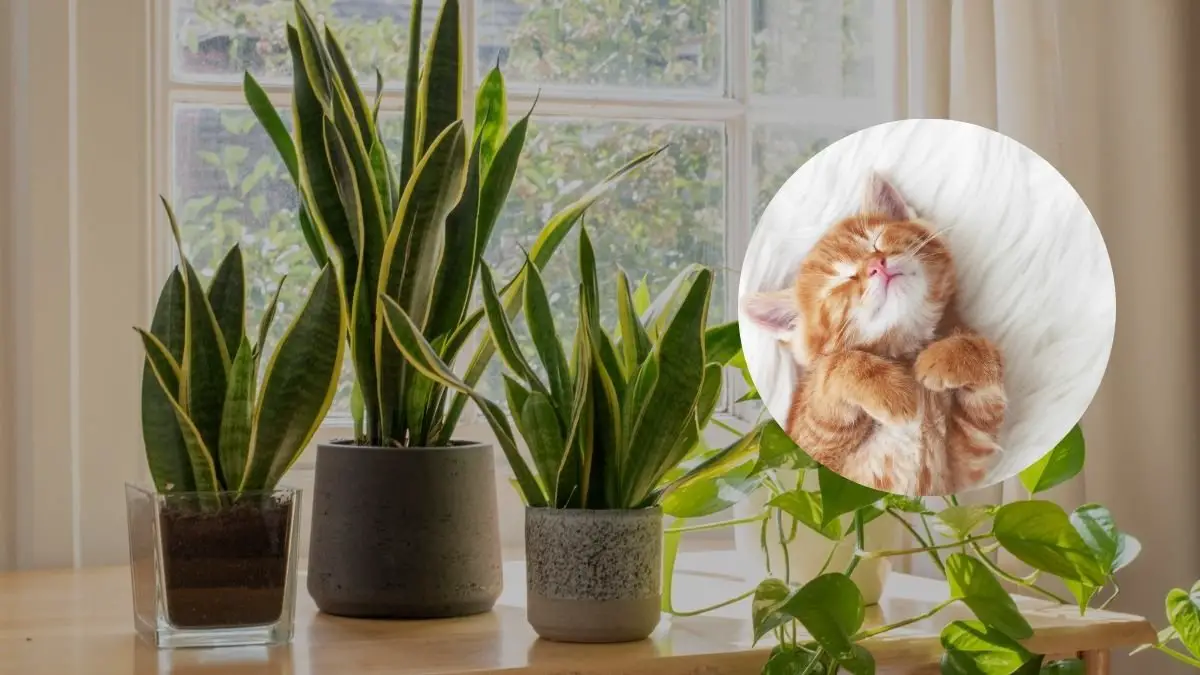Did you know that the snake plant, also known as Sansevieria, is a popular choice for indoor greenery? Surprisingly, this trendy plant is not just a stylish addition to your home; it also boasts air-purifying qualities. However, when it comes to pet owners, there's a lingering concern - is the snake plant poisonous to cats? Let's delve into this topic to ensure the safety of our furry friends.
Key Takeaways
- Be Aware of the Risks: Snake plants can be toxic to cats if ingested, causing symptoms like vomiting and diarrhea.
- Seek Veterinary Help: If you suspect your cat has been poisoned by a snake plant, contact a vet immediately for proper diagnosis and treatment.
- Secure Your Plants: Keep snake plants out of reach of pets or opt for pet-friendly alternatives to prevent poisoning incidents.
- Monitor Your Pets: Watch for signs of poisoning in cats such as drooling, lethargy, or loss of appetite after exposure to snake plants.
- Educate Yourself: Understand the potential dangers of snake plants to cats and learn how to create a safe environment for your pets.
- Choose Safe Options: Consider non-toxic plants like spider plants or palms as alternatives to snake plants for a pet-friendly home environment.
Understanding Snake Plants
Snake plants, also known as mother-in-law's tongue, are popular indoor plants due to their air-purifying qualities and low maintenance requirements.
Types and Varieties
Snake plants come in various types, such as the Sansevieria trifasciata (commonly known as the variegated snake plant) and the Sansevieria cylindrica. These plants vary in appearance, with some featuring long, flat leaves while others have cylindrical ones. Each type has its unique growth pattern, from compact rosettes to tall, upright foliage.
e snake plant varieties boast striking patterns on their leaves, like the Sansevieria trifasciata 'Moonshine' with its silvery-green hue. Others, such as the Sansevieria cylindrica, showcase cylindrical leaves that add a touch of elegance to any indoor space.
Benefits and Uses
Snake plants are renowned for their ability to purify indoor air by removing toxins like formaldehyde and benzene. Their efficient air-purifying properties make them ideal additions to homes or offices where clean air is essential.
In addition to their air-cleansing benefits, snake plants serve as decorative elements that can enhance the aesthetics of any room. With their striking foliage and varying heights, these plants add a touch of greenery and sophistication to interior spaces.
Furthermore, snake plants are incredibly easy to care for, requiring minimal attention compared to other houseplants. Their resilience makes them perfect for busy individuals or those new to plant care.
Toxicity Overview
While snake plants offer numerous benefits, it's crucial to note that they are toxic to cats and dogs if ingested. The plant contains saponins, which can cause gastrointestinal issues like vomiting and diarrhea in pets upon consumption.
Due to these toxic properties, pet owners should exercise caution when keeping snake plants in homes shared with furry companions. Ingestion of any part of the plant can lead to discomfort for pets and potential visits to the veterinarian.
Why Snake Plants Are Dangerous to Cats
Chemical Composition
Snake plants contain saponins, a type of natural chemical compound. These saponins are responsible for the plant's toxic properties. When ingested by pets, saponins can cause gastrointestinal issues like vomiting and diarrhea.
The presence of saponins in snake plants is what makes them harmful to cats. These compounds can irritate the digestive system when consumed, leading to discomfort and potential health complications for pets. Snake plants also contain other toxic components such as alkaloids, which can further contribute to their toxicity.
Toxicity Mechanism
Saponins in snake plants can disrupt the normal functioning of pets' gastrointestinal tracts. Upon ingestion, these compounds can lead to irritation and inflammation in the stomach and intestines, causing symptoms like nausea and abdominal pain in cats and dogs.
The toxins present in snake plants interfere with pets' digestive processes, disrupting nutrient absorption and causing discomfort. Over time, repeated exposure to these toxins can result in more severe issues like dehydration and lethargy in animals that have ingested parts of the plant.
In pets, the mechanisms of snake plant toxicity primarily involve gastrointestinal distress. The toxins present in these plants can trigger reactions ranging from mild stomach upset to more serious conditions like organ damage if ingested frequently or in large quantities.
Recognizing Poisoning Symptoms in Cats
Common Signs
- Vomiting: One of the most common symptoms of snake plant poisoning in cats is vomiting.
- Diarrhea: Another indicator that a cat may have ingested a snake plant is diarrhea.
- Lethargy: Cats poisoned by a snake plant may exhibit signs of lethargy or weakness.
Pet owners can recognize signs of toxicity in their animals by observing any unusual behavior such as excessive drooling, lack of appetite, or difficulty breathing. If a cat displays any of these symptoms after being around a snake plant, it's crucial to seek veterinary assistance immediately.
Examples of common indicators that a pet may have ingested a snake plant include excessive salivation, dilated pupils, and abdominal pain. These signs should not be ignored and require prompt attention to ensure the well-being of the animal.
Immediate Actions
- If a pet ingests a snake plant, the immediate step is to contact a veterinarian for guidance.
- It is crucial to act promptly by providing information about the type and amount of plant ingested.
- Removing the snake plant from the pet's vicinity is essential to prevent further exposure.
Acting swiftly in case of potential toxicity can make a significant difference in the outcome for the affected pet. Delaying medical intervention can lead to more severe health complications for cats exposed to poisonous plants like the snake plant.
Taking quick action includes seeking professional help without delay, monitoring the pet's condition closely for any worsening symptoms, and following any treatment recommendations provided by the veterinarian. Remember, every minute counts when dealing with potential poisoning incidents involving pets.
Treating Snake Plant Poisoning
First Aid Steps
Administering first aid to pets affected by snake plant poisoning is crucial. If your pet shows symptoms, act promptly. Initially, wash any exposed areas on your pet with water to remove toxins.
Ensure your pet does not ingest more of the plant. Offer milk to drink to dilute the toxins in their system. Do not induce vomiting without veterinary advice as it can worsen the condition.
While waiting for professional help, keep your pet calm and monitor their symptoms closely. Place them in a quiet, comfortable area away from potential hazards.
When to See a Vet
Immediate veterinary assistance is necessary if your pet displays severe symptoms like vomiting, diarrhea, or difficulty breathing after exposure to the snake plant.
Seek professional help without delay if you suspect your pet has ingested any part of the plant. Do not wait for symptoms to escalate before consulting a vet.
If your pet's condition worsens or they exhibit signs of distress such as drooling excessively or collapsing, do not hesitate to contact a veterinarian immediately.
Preventing Poisoning Incidents
Safety Measures
To safeguard your pets from snake plant toxicity, place these plants out of reach or in areas inaccessible to cats. Ensure your home is a pet-friendly environment by removing potential hazards like toxic plants. Consider placing snake plants on high shelves or using hanging baskets to prevent pets from accessing them. Avoid planting snake plants in outdoor areas where pets roam freely. Be cautious while handling snake plants, as their toxicity can harm animals if ingested.
- Keep snake plants away from curious pets
- Create barriers to prevent access to toxic plants
When training your pets, focus on teaching them to avoid interacting with harmful flora like snake plants. Use positive reinforcement techniques such as rewards for good behavior around plants and redirection when they approach toxic foliage. Implement consistent training methods to help pets understand the difference between safe and toxic plants in the household environment.
Training Pets
Train your pets through consistent behavioral strategies to deter them from consuming toxic plants like snake plants. Use deterrent sprays or smells that discourage pets from approaching these harmful flora. Employ interactive play and mental stimulation activities to divert their attention away from potentially dangerous plant species.
- Consistent training methods
- Positive reinforcement techniques
Safe Alternatives for Pet Owners
Non-toxic Plants
When choosing houseplants, consider pet-friendly options like Spider Plant, Boston Fern, and Parlor Palm. These plants are safe for pets.
Pet owners can create a green environment at home by opting for non-toxic plants such as the Areca Palm and Bamboo Palm.
Incorporating pet-safe plants in indoor spaces not only adds a touch of nature but also ensures the safety of furry friends.
Pet-friendly Decor
Integrate pet-safe plants into your home decor by placing them on high shelves or using hanging planters out of reach of pets.
Creative ideas include using plant stands, wall-mounted shelves, or terrariums to display non-toxic plants without endangering pets.
Pet-friendly decor featuring non-toxic plants not only enhances the aesthetic appeal of a space but also promotes a safe environment for pets to thrive.
FAQs on Snake Plants and Pets
Identifying Ingestion
Pet owners can determine if their pet has ingested a toxic plant like a snake plant by observing symptoms such as vomiting, diarrhea, drooling, or lethargy. If these signs are present, immediate veterinary attention is crucial.
Recognize symptoms of plant poisoning in animals which may include gastrointestinal upset, oral irritation, difficulty breathing, or changes in behavior. Quick action is essential to prevent further harm to the pet.
Monitor pets for signs of ingestion and toxicity by keeping an eye out for unusual behaviors like excessive salivation, lack of appetite, or weakness. Contact a veterinarian promptly if any concerning symptoms arise.
Toxicity to Other Animals
Apart from cats and dogs, snake plant toxicity can also impact other animals like birds or small mammals. These creatures may exhibit adverse reactions when exposed to the toxins present in the plant.
Birds are particularly sensitive to certain substances found in snake plants and can experience respiratory distress or digestive issues if they come into contact with them. Similarly, small mammals like rabbits or guinea pigs may suffer from gastrointestinal problems if they ingest parts of the plant.
Understanding the broader implications of toxic plants on various animal species is crucial for all pet owners. It highlights the importance of creating a safe environment for all pets and being aware of potential hazards within the home.
Final Remarks
In understanding the dangers of snake plants to your feline friends, recognizing poisoning symptoms, and learning how to treat and prevent incidents, you are equipped to safeguard your beloved pets. By opting for safe alternatives and being vigilant, you can create a pet-friendly environment that ensures the well-being of your cats. Remember, your furry companions rely on you for their safety and health.
Take action today by securing your home against potential hazards, choosing pet-friendly plant options, and staying informed about common household dangers. Your proactive approach will not only protect your pets but also provide them with a nurturing and secure space to thrive in. Keep your furry friends safe and healthy – they deserve it!
Frequently Asked Questions
Is the snake plant toxic to cats?
Yes, snake plants are toxic to cats. Ingesting any part of the plant can cause symptoms like vomiting, diarrhea, and lethargy in cats.
How can I recognize if my cat has been poisoned by a snake plant?
Look out for symptoms such as drooling, difficulty breathing, loss of appetite, and vomiting. If you suspect poisoning, seek immediate veterinary help.
What should I do if my cat ingests a snake plant?
If your cat consumes a snake plant, contact your veterinarian or an emergency animal poison control hotline immediately for guidance.
Can snake plants be harmful to other pets besides cats?
Snake plants can also be toxic to dogs and other animals if ingested. Keep all pets away from these plants to prevent poisoning incidents.
Are there safe alternatives to snake plants for pet owners?
Yes, there are pet-friendly houseplants like spider plants, Boston ferns, and African violets that are safe for homes with cats and dogs.
Image Source: Paid image from CANVA




